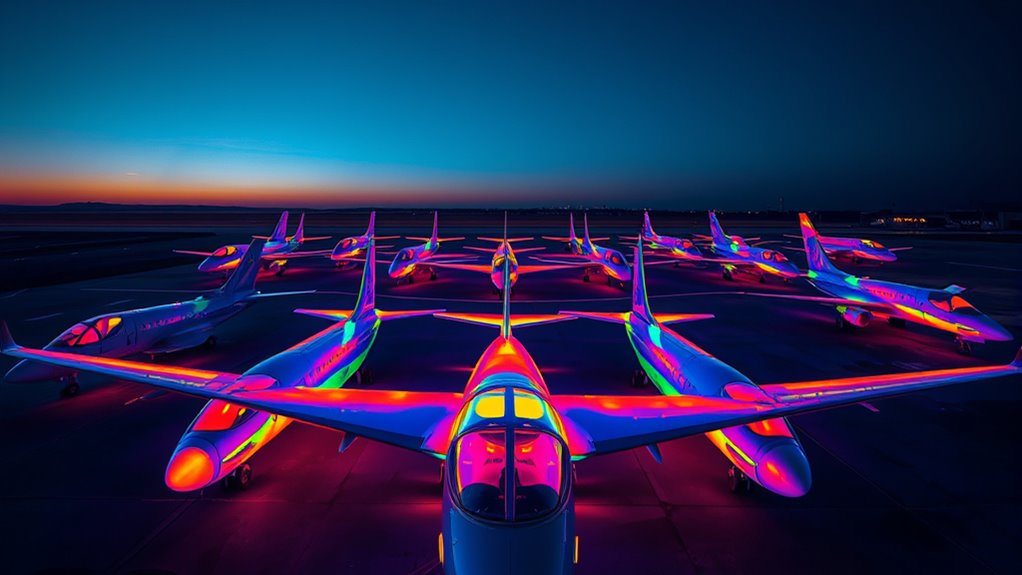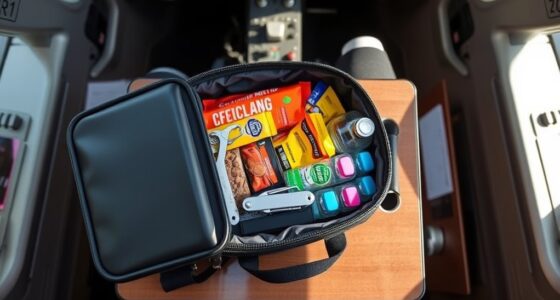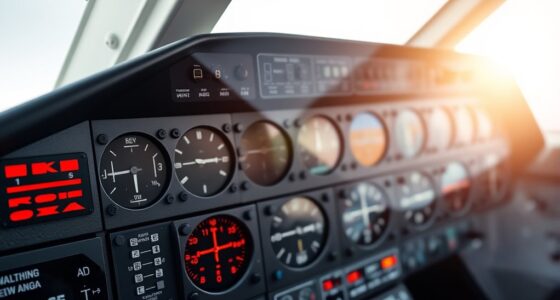If you’re looking for the best thermal-imaging cameras for aviation professionals and enthusiasts, I recommend models like TOPDON TC004, F2VW, HF96, H128, and KAIWEETS KTI-200 for their high resolution, durability, and advanced features like fusion modes and fault detection. Compact, rugged, and packed with real-time capabilities, these devices can handle demanding environments. Want to discover more about each option and find the perfect fit for your needs? Keep exploring for detailed insights.
Key Takeaways
- High-resolution IR sensors (up to 512×384) enable detailed inspection of aircraft components and structural integrity.
- Features like fusion modes, heatmaps, and deep learning fault detection assist in precise aviation diagnostics.
- Rugged, weather-resistant designs with long battery life ensure durability in demanding aviation environments.
- Real-time imaging at 25Hz allows quick identification of hotspots, electrical faults, and leaks during inspections.
- Compact, portable models with Wi-Fi sharing facilitate on-the-spot analysis and remote collaboration for aviation professionals.
TOPDON TC004 Thermal Imaging Camera
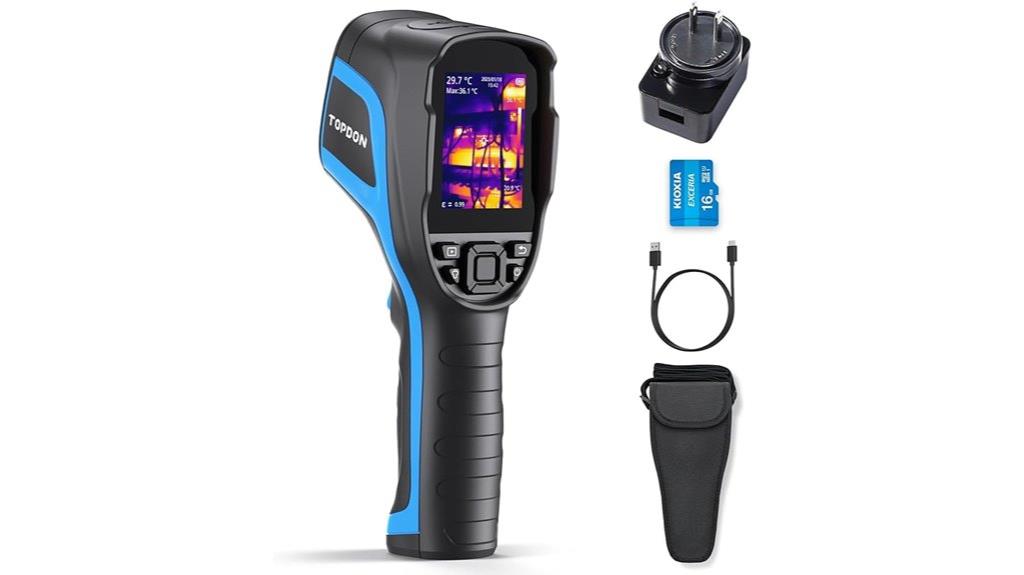
If you’re looking for a reliable thermal imaging camera tailored for aviation applications, the TOPDON TC004 stands out with its high-resolution 256×192 IR sensor and fast 25Hz frame rate. I find its thermal sensitivity of less than 40mk and temperature range from -4°F to 662°F perfect for detecting issues like electrical faults or structural defects. Its auto/manual focus, multiple color palettes, LED work light, and long-lasting 12-hour battery make it versatile and easy to use in rugged environments. The device supports live image streaming on PC, video recording, and expandable 32GB memory. Overall, it’s a professional-grade tool that combines precision, durability, and convenience for aviation and technical inspections.
Best For: professionals and technicians in aviation, electrical, industrial, and maintenance fields seeking precise thermal imaging for detailed inspections.
Pros:
- High-resolution 256×192 IR sensor delivers clear, detailed thermal images.
- Fast 25Hz frame rate enables smooth real-time monitoring and detection.
- Long-lasting 12-hour battery and rugged design make it suitable for demanding environments.
Cons:
- Software download involves RAR files requiring additional tools like WINZIP, which may incur costs.
- Some users experience lag during post-processing and file management.
- Manual explanations for settings like emissivity and distance are not very detailed, possibly affecting ease of use.
F2VW Thermal Camera with IR and Visual Cameras
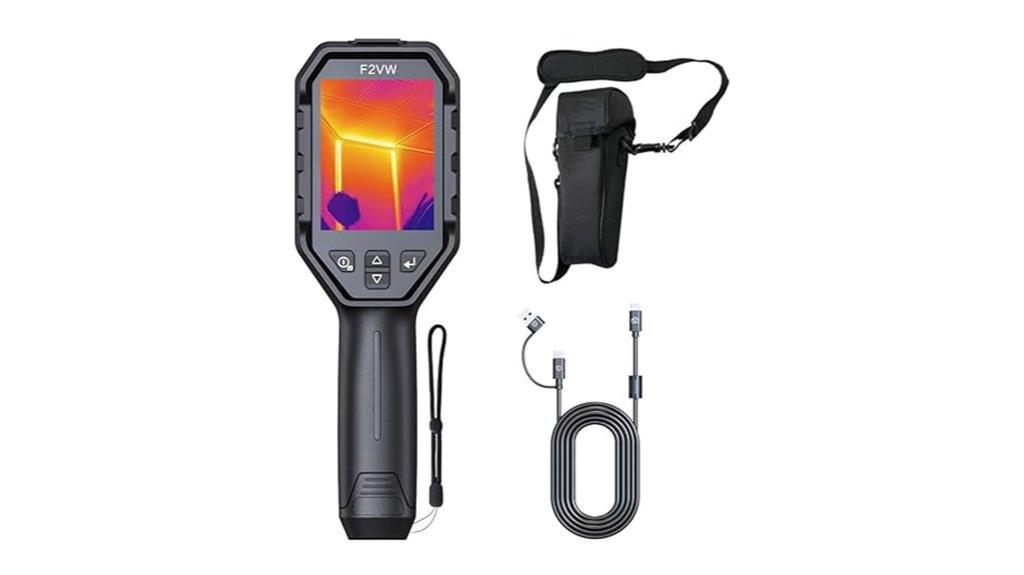
The F2VW Thermal Camera with IR and Visual Cameras stands out as an ideal choice for aviation professionals who need high-resolution thermal imaging combined with versatile image modes. It features a Super Resolution algorithm that boosts real-time images from 256×192 to 640×480 pixels, displayed smoothly on a 3.2-inch LCD at 25 Hz. With thermal sensitivity below 40 mK, it captures high-definition details. The dual-camera setup allows switching between Visual, Thermal, Fusion, and PIP modes, with seven color palettes for tailored inspections. Its compact design, Wi-Fi sharing, and temperature measurement capabilities make it a powerful tool for identifying anomalies and ensuring safety in aviation environments.
Best For: aviation professionals seeking high-resolution thermal imaging combined with versatile image modes for accurate inspection and safety assurance.
Pros:
- Equipped with Super Resolution technology enhancing thermal image clarity from 256×192 to 640×480 pixels.
- Offers multiple imaging modes (Visual, Thermal, Fusion, PIP) with seven customizable color palettes for comprehensive analysis.
- Compact, portable design with Wi-Fi connectivity and additional features like LED flashlight and tripod mount for versatile use.
Cons:
- Slightly higher cost due to advanced features and high-resolution capabilities.
- Requires familiarity with thermal imaging and image analysis for optimal use.
- Battery life may be limited during prolonged inspections, necessitating additional power sources.
HF96 Thermal Camera with Infrared Resolution
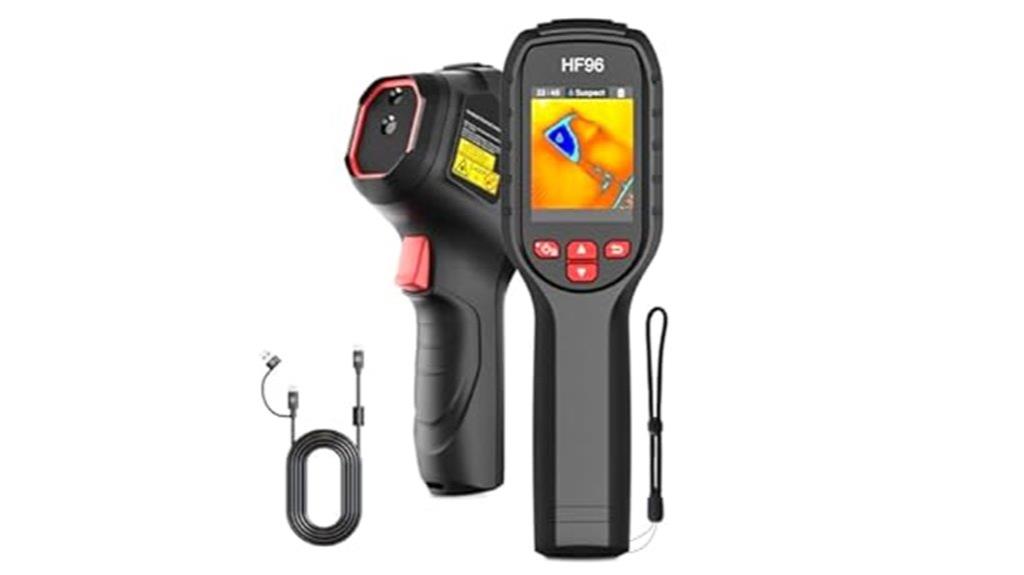
The HF96 Thermal Camera’s high infrared resolution of 96 x 96 pixels makes it an excellent choice for aviation professionals seeking quick, accurate thermal assessments. Its ability to detect temperatures from -4°F to 1022°F, combined with intelligent scene recognition and deep learning-powered IntellFault technology, streamlines fault detection. The device integrates a thermal camera, thermometer, and laser pointer into a user-friendly tool, supporting real-time heatmap visualization and multiple color palettes. With a 50° field of view and live super resolution enhancement, it ensures clear images and fast anomaly recognition. Durable and portable, the HF96 is perfect for on-the-go inspections, offering reliable performance for both experts and enthusiasts.
Best For: DIY homeowners, electrical troubleshooters, and HVAC professionals seeking an affordable, reliable thermal imaging tool for broad-area inspections and quick fault detection.
Pros:
- Supports real-time super resolution enhancement for clearer images
- Features intelligent scene recognition with deep learning for automated fault detection
- Durable, lightweight design with long battery life and portable form factor
Cons:
- Limited IR resolution (96 x 96) may miss small hotspots or detailed defects
- Slightly slow image refresh rate can affect real-time tracking of moving issues
- Small target detection may be challenging due to resolution constraints
H128 Handheld Thermal Camera
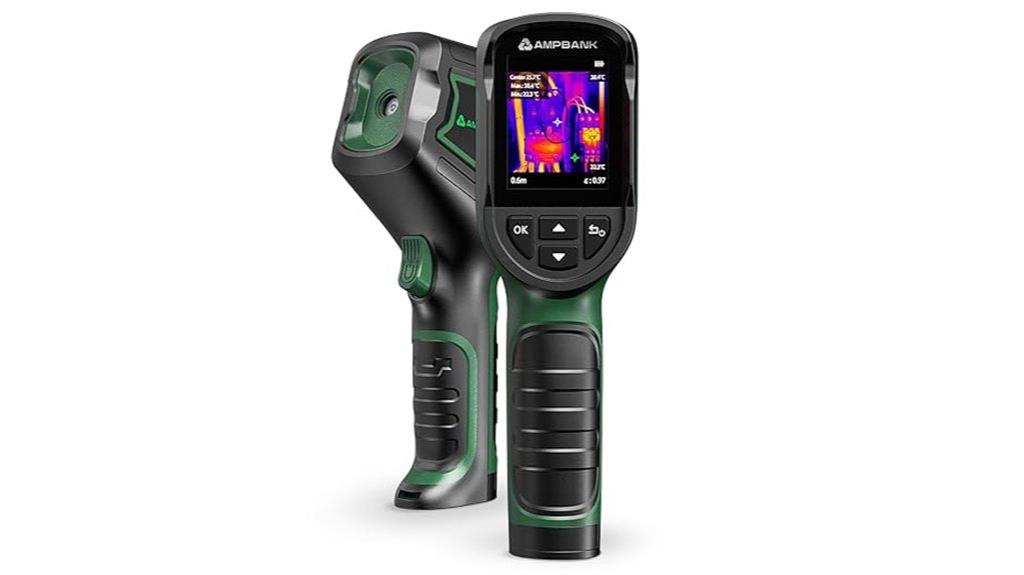
Designed for precise thermal detection, the H128 Handheld Thermal Camera stands out with its high-resolution 240×240 thermal imaging, making it ideal for aviation professionals who need quick, accurate insights into heat sources. Its enhanced clarity, combined with a 40mk sensitivity, allows detection of minute temperature differences. The device offers multiple color palettes and a 240×240 display for clear visualization. With temperature measurement accuracy within ±3% and built-in alarms, it ensures reliable readings. Its durable, portable design features up to 24 hours of battery life, IP65 protection, and easy one-handed operation. The H128 is perfect for inspecting aircraft components, detecting hotspots, or monitoring heat leaks efficiently.
Best For: aviation professionals and technicians who require quick, accurate thermal inspections of aircraft components and heat sources in challenging environments.
Pros:
- High-resolution 240×240 thermal imaging with 40mk sensitivity for detecting minute temperature differences
- Durable, compact design with IP65 protection and up to 24 hours of battery life for extended use in tough conditions
- Easy one-handed operation with intuitive controls and multiple color palettes for versatile visualization
Cons:
- Small display size may limit detailed viewing and analysis
- Slight lag at 25Hz refresh rate can impact real-time imaging smoothness
- No included power adapter, requiring USB-C recharging and photo transfer
TOPDON TC004 Mini Handheld Thermal Imaging Camera

If you’re seeking a portable thermal imaging solution that combines high resolution with ease of use, the TOPDON TC004 Mini stands out as an excellent choice. It features a 128×128 IR resolution, upscale to 240×240 for detailed images, and a 25Hz refresh rate for smooth viewing. With a wide temperature range from -4°F to 842°F, it’s versatile across various tasks. Its five color palettes enable customization, while automatic detection of hot and cold spots improves accuracy. Compact, durable, and lightweight, it fits easily in your pocket and offers up to 15 hours of battery life. Perfect for diagnostics, inspections, and on-the-go use, it’s a reliable, cost-effective tool for enthusiasts and professionals alike.
Best For: DIY enthusiasts, home inspectors, and automotive professionals seeking a portable, high-resolution thermal imaging device for accurate diagnostics and inspections.
Pros:
- High-resolution imaging with 128×128 IR sensor upscaled to 240×240 for detailed visuals
- Long battery life of up to 15 hours, suitable for extended use in the field
- Durable, compact design with waterproof rating (IP54) and drop resistance up to 2 meters
Cons:
- Excludes a power adapter from the package, requiring an additional purchase for charging
- Limited to 512MB eMMC storage, which may fill up quickly with frequent high-volume photo capture
- Manual focus and other advanced settings may be limited, affecting fine-tuned adjustments
Handheld Thermal Camera with 512×384 Resolution
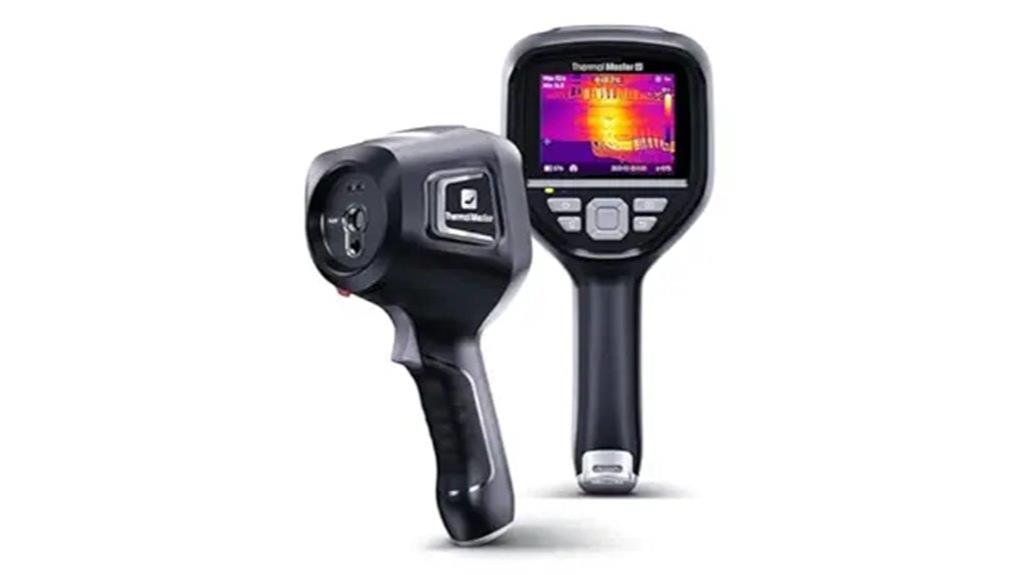
A handheld thermal camera with 512×384 resolution offers exceptional detail and clarity, making it ideal for aviation professionals who need precise thermal diagnostics in the field. Its upgraded X³ IR technology provides sharp images with real-time upscaling, ensuring minimal lag during motion. The device supports multiple modes like Picture-in-Picture and fusion overlay, blending thermal and visual data for better interpretation. Its 3.5-inch IPS display delivers crisp visuals day or night, while features like laser pointer, flashlight, and adjustable emissivity enhance accuracy. With a rugged build, long battery life, and extensive data management options, this camera is a versatile tool for inspecting electrical, mechanical, and structural components in aviation.
Best For: aviation professionals and field inspectors requiring high-resolution thermal diagnostics for electrical, mechanical, and structural components in outdoor or in-flight environments.
Pros:
- High 512×384 thermal resolution delivers detailed and clear thermal images for precise diagnostics.
- Upgraded X³ IR technology with real-time upscaling minimizes lag and enhances image quality during motion.
- Versatile modes like Picture-in-Picture and fusion overlay improve image interpretation by blending thermal and visual data.
Cons:
- Lacks a macro lens for close-up inspections of small components, which may limit detailed analysis.
- Interface does not support a button hold feature for continuous scrolling or capturing.
- Not weather-sealed, so additional protection may be needed for harsh outdoor conditions.
HF96 Thermal Camera with 240×240 Resolution
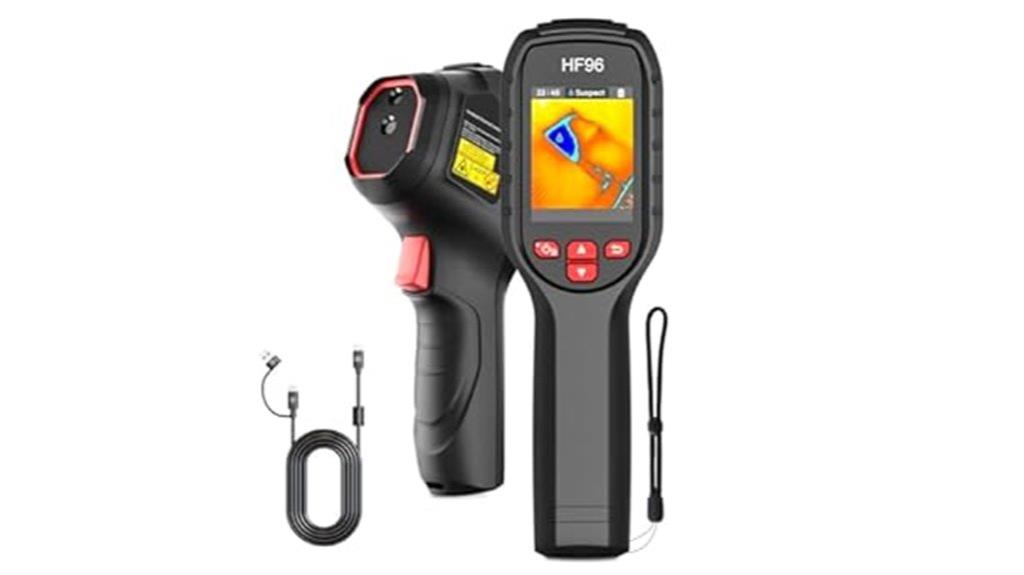
The HF96 Thermal Camera with 240×240 resolution stands out as an ideal tool for aviation professionals who need quick, reliable thermal diagnostics in demanding environments. Its super resolution enhances image clarity in real-time, making it easier to spot issues like electrical faults or heat leaks. With a broad temperature range and intelligent scene recognition powered by deep learning, it automates defect detection, saving time. The device’s durable IP54 housing, long battery life, and tripod support ensure it performs reliably in tough conditions. Compact and user-friendly, the HF96 is perfect for on-the-go inspections, providing detailed insights that improve safety and maintenance efficiency.
Best For: aviation professionals and inspectors needing quick, reliable thermal diagnostics in demanding environments.
Pros:
- Real-time super resolution enhances image clarity for precise diagnostics.
- Durable IP54-rated housing and long battery life ensure reliable performance in tough conditions.
- Automated defect detection with deep learning saves time and improves inspection accuracy.
Cons:
- Slightly limited resolution for very small hotspot identification.
- Slow image refresh rate may affect real-time monitoring in fast-changing scenarios.
- Higher cost compared to basic thermal cameras, which might be a consideration for budget-conscious users.
HP96 Thermal Imaging Camera with Visual Screen
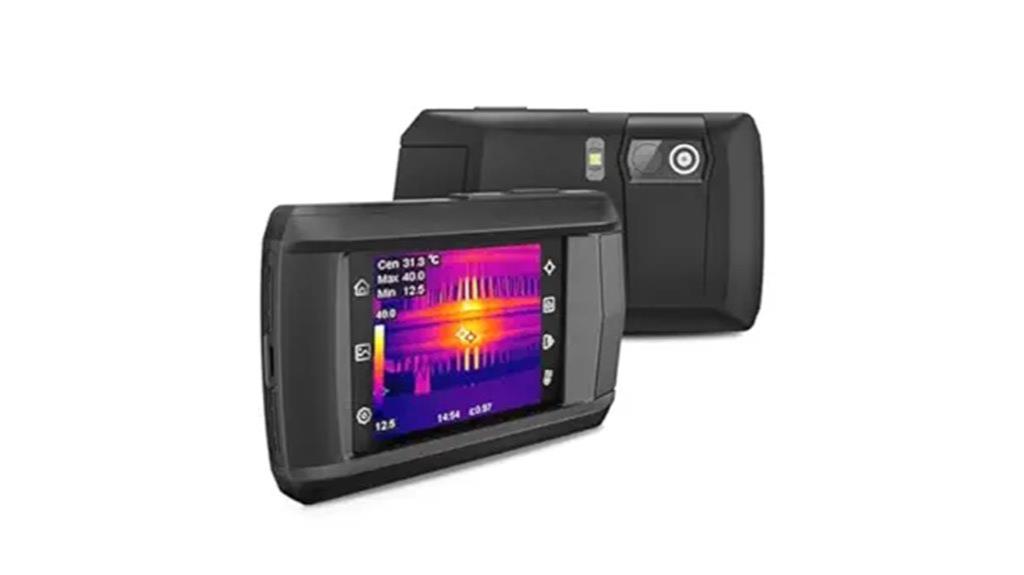
For aviation professionals seeking an accessible yet powerful thermal imaging tool, the HP96 Thermal Imaging Camera with Visual Screen offers an ideal balance of features. Its live super resolution boosts clarity from 96×96 to 240×240 pixels, delivering detailed thermal images in real-time. The dual cameras—thermal and visible—support versatile modes like Fusion and PIP, with eight color palettes for various detection needs. The 25Hz frame rate ensures smooth visuals, while the 50° field of view covers broad areas efficiently. With built-in recording, scene recognition, and adjustable settings, the HP96 simplifies inspections, making it a practical choice for both professionals and enthusiasts.
Best For: aviation professionals and enthusiasts seeking an accessible, feature-rich thermal imaging tool for detailed inspections and broad detection scenarios.
Pros:
- Live super resolution enhances thermal image clarity from 96×96 to 240×240 pixels in real-time.
- Dual cameras (thermal and visible) support versatile modes like Fusion and PIP with multiple color palettes.
- Compact, rugged design with built-in recording, scene recognition, and adjustable settings for easy operation.
Cons:
- Modest resolution may limit detection of very small thermal differences for professional-grade diagnostics.
- Occasional calibration delays and interface quirks can affect user experience.
- Some units have experienced quality control issues, such as initial uncharged batteries or performance inconsistencies.
FLIR ONE Gen 3 Thermal Imaging Camera for iOS Smartphones
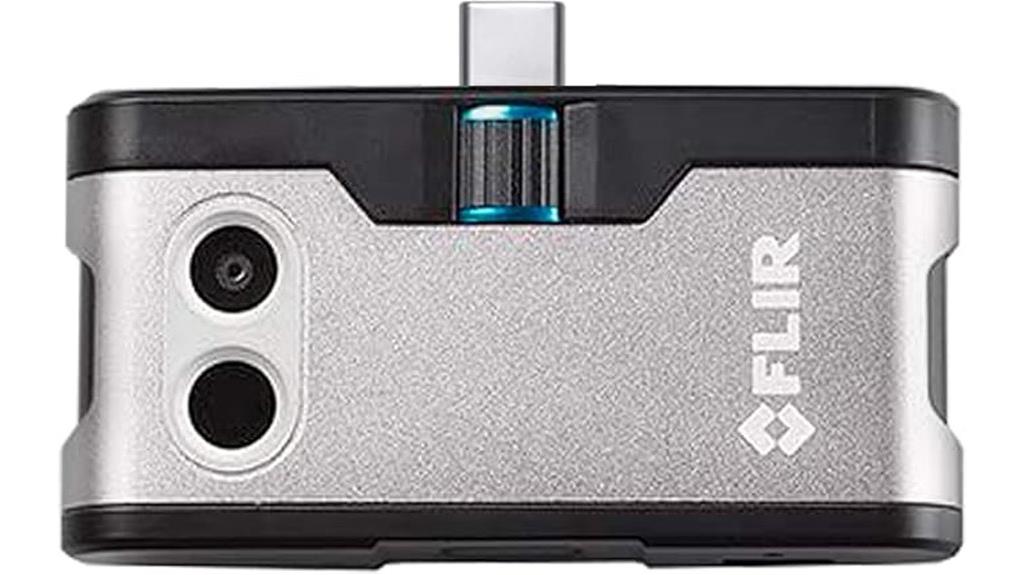
If you’re looking for an affordable, portable thermal imaging solution compatible with iOS smartphones, the FLIR ONE Gen 3 stands out as an excellent choice. It connects directly to iPhones with USB-C ports, offering high-resolution IR images with 1440×1080 visual clarity and 80×60 thermal resolution. The device is compact, lightweight, and rugged enough to withstand drops from 1.5 meters, making it suitable for both home inspections and fieldwork. Its MSX technology overlays visible details onto thermal images, improving hotspot detection. Overall, it’s a user-friendly tool that enhances troubleshooting, energy audits, and outdoor exploration, all at a reasonable price point.
Best For: homeowners, hobbyists, and professionals seeking an affordable, portable thermal imaging tool compatible with iOS smartphones for home inspections, troubleshooting, and outdoor exploration.
Pros:
- High-resolution thermal images with 1440×1080 visual clarity and 80×60 thermal resolution
- Compact, lightweight, and rugged design with durability for field use
- User-friendly with MSX overlay technology for improved hotspot detection
Cons:
- Limited temperature range compared to higher-end models (-4°F to 248°F)
- Potential strain on the phone’s USB-C port due to device weight and placement
- Less suitable for heavy-duty or industrial applications requiring more advanced features
F2W Thermal Camera with IR Resolution, 3.2″ Screen, 25Hz, -4°F to 1022°F, App & PC Analysis
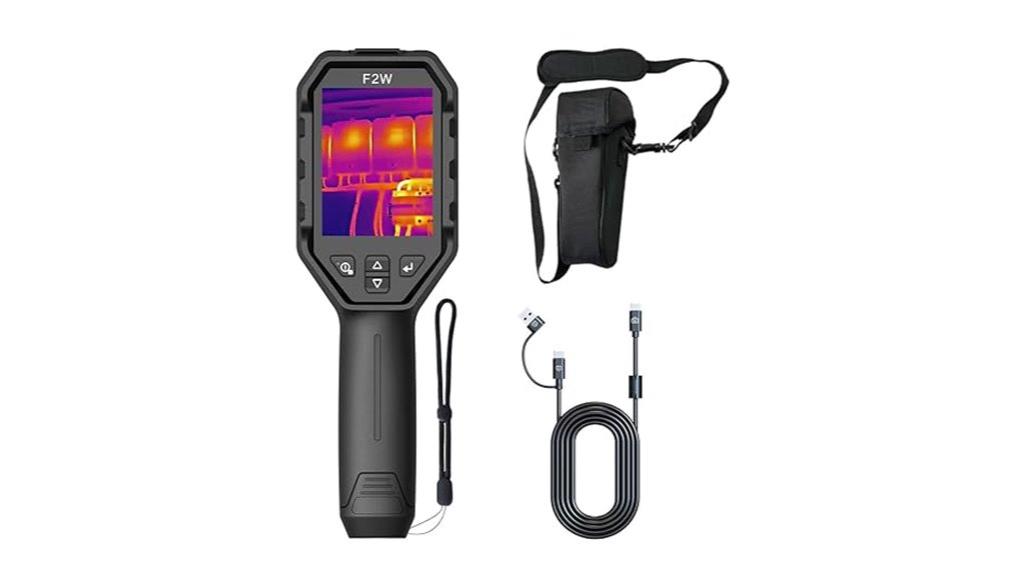
Designed with precision and speed in mind, the F2W Thermal Camera is ideal for aviation professionals who need rapid, accurate thermal assessments. It features a 256×192 IR detector upgraded to 640×480 resolution with HSFTOOLS Super Resolution, ensuring sharp images and detailed temperature readings. With a 3.2″ screen and 25Hz refresh rate, it delivers HD imaging that’s easy to interpret. The camera supports temperatures from -4°F to 1022°F and offers automatic monitoring of hot and cold spots, plus alerts for anomalies. Wi-Fi connectivity and PC software enable seamless analysis, making it a versatile tool for quick, reliable inspections in aviation environments.
Best For: professionals in aviation and industrial maintenance seeking rapid, precise thermal imaging and detailed analysis tools.
Pros:
- High-resolution upgrade to 640×480 with HSFTOOLS Super Resolution for clearer images
- Fast 25Hz refresh rate ensures smooth, real-time thermal monitoring
- Seamless connectivity with app and PC software for comprehensive analysis and reporting
Cons:
- Initial display artifacts reported, though support addresses these issues promptly
- Slightly higher price point compared to basic models, reflecting advanced features
- Requires familiarity with software for maximum benefit, potentially steep learning curve for beginners
TOPDON TC004 Thermal Imaging Camera with 320×240 Resolution

The TOPDON TC004 Thermal Imaging Camera stands out with its 256×192 IR resolution and multiple measurement modes, making it an excellent choice for aviation professionals who need detailed thermal analysis in challenging environments. It features thermal sensitivity below 40mK, a temperature range from -4°F to 662°F, and a 25Hz frame rate for smooth imaging. The device offers auto/manual focus, various color palettes, and built-in LED work light. Its compact, rugged design includes a rechargeable battery supporting up to 12 hours of continuous use, with USB-C connectivity for PC analysis. Ideal for inspections, troubleshooting, and diagnostics, it combines portability with professional-level performance.
Best For: aviation professionals and technicians who require detailed thermal analysis in challenging environments and need portable, reliable imaging tools.
Pros:
- High thermal sensitivity below 40mK for detailed thermal detection
- Rugged, compact design with long battery life up to 12 hours
- Multiple measurement modes and color palettes for versatile analysis
Cons:
- Software download involves additional costs and complex file management
- Lack of built-in emissivity reference guides or manual explanations for certain settings
- Some users experience lag during post-processing and image review
HF256 Thermal Imaging Camera with 256×192 IR Resolution
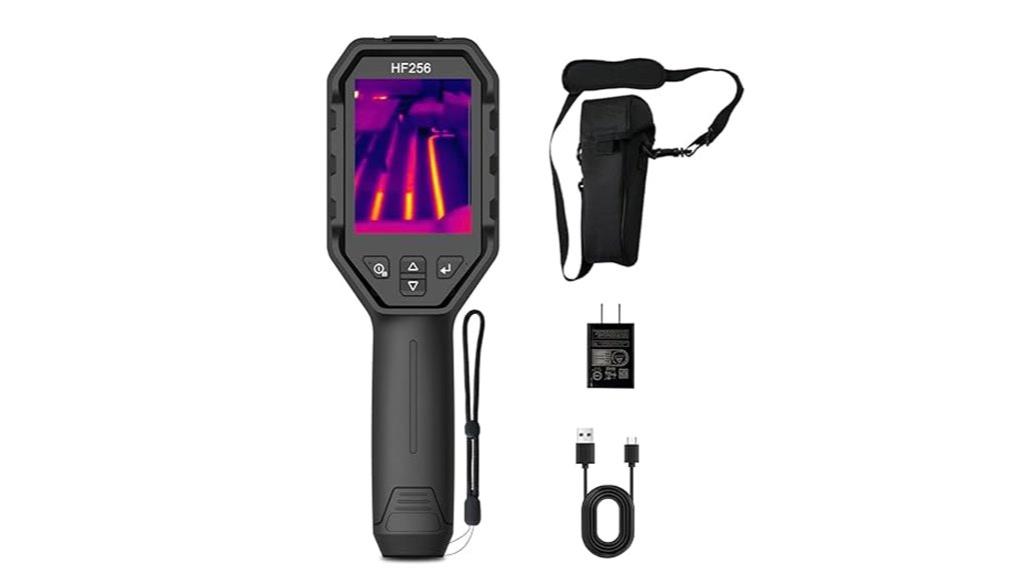
The HF256 thermal imaging camera stands out for aviation professionals who need reliable, high-resolution thermal detection in demanding environments. Its use of the HSFTOOLS Snapshot Super Resolution algorithm boosts resolution from 256×192 to 320×240 pixels, delivering clearer images. With thermal sensitivity below 40 mK and a smooth 25 Hz frame rate, it captures high-definition details in real time. The compact design includes a 3.2-inch LCD with six color palettes, making it adaptable for various scenarios. Built for durability, it withstands tough conditions and offers features like adjustable emissivity, temperature alarms, and extensive data storage, making it a versatile choice for field inspections and safety monitoring.
Best For: aviation professionals and field inspectors seeking reliable, high-resolution thermal imaging in demanding environments for safety and maintenance purposes.
Pros:
- Enhanced image resolution with Snapshot Super Resolution algorithm for clearer visuals
- Durable and rugged design with IP54 rating and impact resistance suitable for harsh conditions
- Long battery life of up to 6 hours and extensive data storage capacity for prolonged use
Cons:
- Slightly higher cost due to advanced features and durable build
- Requires some familiarity with emissivity settings for accurate measurements on different materials
- Limited to 256×192 IR resolution before software enhancement, which may be less detailed compared to higher-end models
KAIWEETS KTI-200 Thermal Camera

If you’re looking for a reliable thermal camera that delivers crisp, detailed images in demanding aviation environments, the KAIWEETS KTI-200 stands out with its high IR resolution and fast refresh rate. It features a 240×240 resolution and a 25Hz refresh rate, ensuring smooth, clear thermal imagery. The 2.4-inch LCD screen provides detailed heat maps, making it easy to detect anomalies and hotspots. With a temperature range from -4°F to 1022°F and built-in laser targeting, it offers precise measurement and targeting even in low-light conditions. Its durable IP54 design, long battery life, and versatile color palettes make it a practical choice for professionals and enthusiasts alike.
Best For: professionals and enthusiasts seeking high-resolution, real-time thermal imaging in demanding environments such as aviation and industrial inspections.
Pros:
- High IR resolution of 240×240 with 25Hz refresh rate for crisp, smooth thermal images
- Accurate temperature measurement from -4°F to 1022°F with ±2% precision
- Durable IP54 design with long 8-hour battery life and comprehensive support
Cons:
- Limited to 2.4-inch LCD display, which may be small for some users
- May be costly compared to basic thermal cameras with fewer features
- No built-in Wi-Fi or advanced connectivity options beyond USB-C for file transfer
FLIR C5 Compact Thermal Imaging Camera
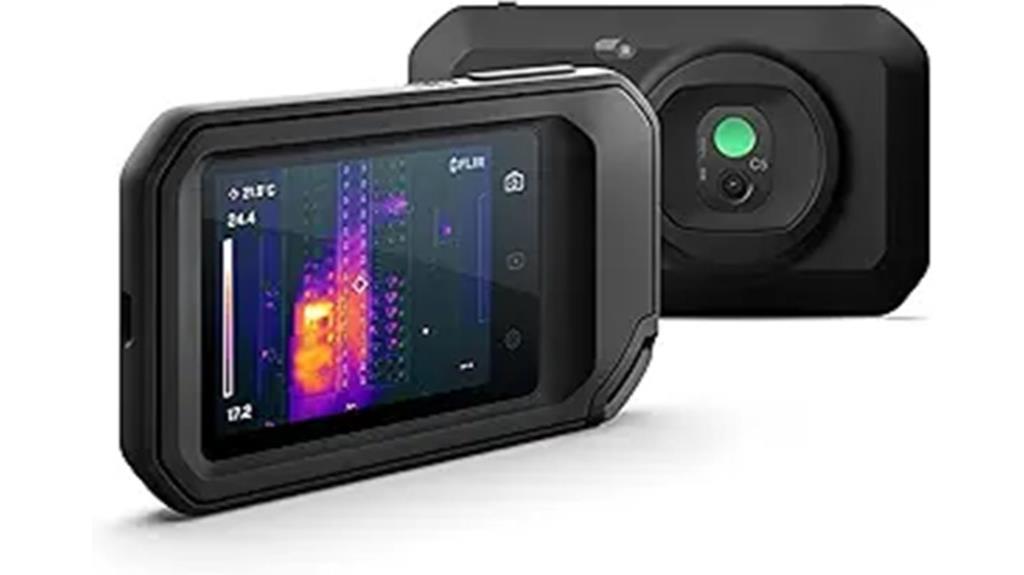
Designed for portability and ease of use, the FLIR C5 Compact Thermal Imaging Camera is an excellent choice for aviation professionals who need quick, reliable thermal diagnostics in the field. Its lightweight design (just 6.7 ounces) and compact size make it easy to handle and carry. The camera features a 160×120 thermal sensor, MSX® technology for detailed images, and a 5MP visual camera. It measures temperatures from -20°C to 400°C, ideal for detecting electrical faults, leaks, or overheating components. Wi-Fi support allows seamless image sharing and professional report creation. Rugged and user-friendly, the C5 simplifies inspections, making it well-suited for aviation and maintenance tasks.
Best For: aviation professionals and maintenance technicians seeking quick, reliable thermal diagnostics in the field.
Pros:
- Lightweight and compact design for easy portability and handling
- High-quality thermal and visual imaging with MSX® technology for detailed diagnostics
- Supports Wi-Fi file transfer for seamless sharing and professional reporting
Cons:
- Limited sensor resolution may affect image detail for complex inspections
- Slower refresh rate (9Hz or less) can impact real-time analysis
- Occasional reports of overheating or intermittent operation over prolonged use
FLIR TG165-X Thermal Imaging Camera
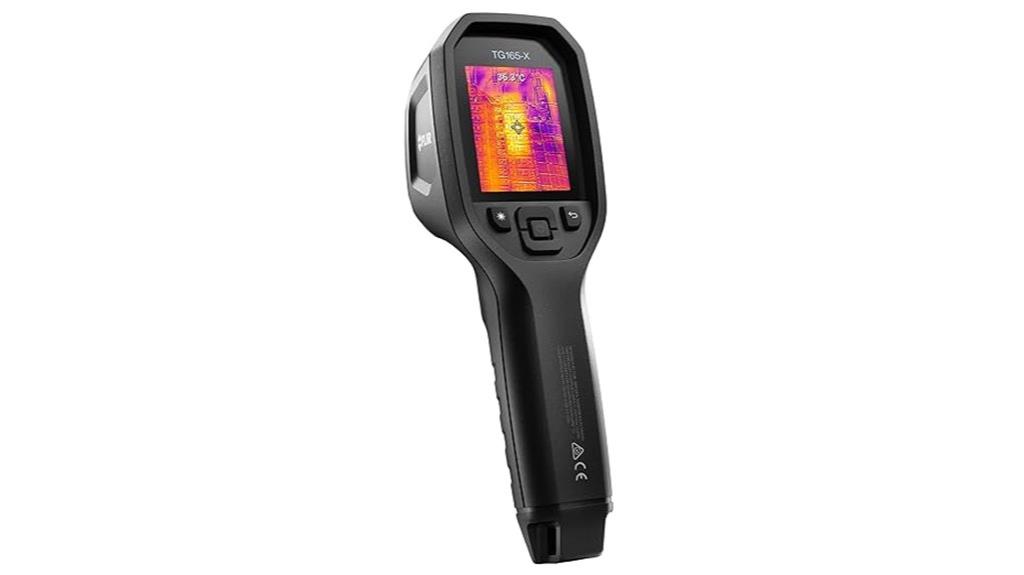
For aviation professionals seeking a reliable thermal imaging tool, the FLIR TG165-X stands out with its intuitive design and robust features. It offers a 4,800-pixel IR sensor that measures temperatures from -25°C to 300°C, with MSX image enhancement for sharper visuals. Its rugged, drop-tested construction and IP54 rating guarantee durability in demanding environments. The device includes a laser pointer, built-in flashlight, and internal storage for 50,000 images. Its user-friendly interface makes it accessible for both amateurs and pros. Despite some software stability issues and limited temperature readings, the TG165-X provides accurate, clear thermal images essential for diagnosing electrical, mechanical, or thermal issues.
Best For: professionals and amateurs seeking a durable, easy-to-use thermal imaging device for building inspections, electrical diagnostics, and mechanical troubleshooting.
Pros:
- Rugged, drop-tested construction with an IP54 rating ensuring durability in tough environments
- MSX image enhancement overlays visual details for clearer thermal images
- Internal storage for up to 50,000 images and user-friendly interface for quick operation
Cons:
- Lacks maximum and minimum temperature readings found in some comparable models
- Software stability issues like freezes and boot loops after prolonged use
- Limited warranty support and challenges with customer service and warranty claims
Factors to Consider When Choosing Thermal‑Imaging Cameras for Aviation
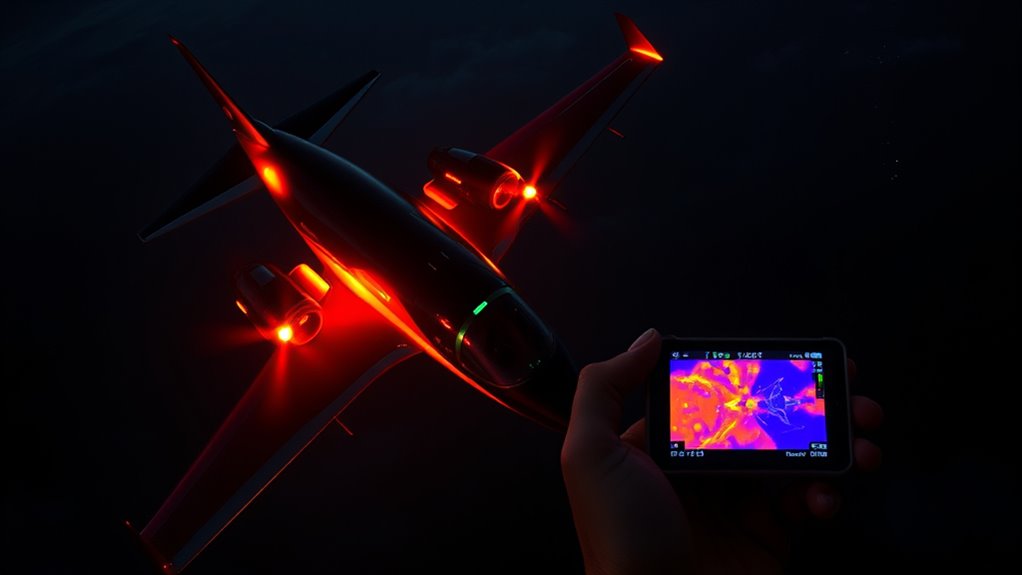
When selecting a thermal-imaging camera for aviation, I focus on key factors like resolution and image clarity to guarantee accurate detection. I also consider the device’s durability, portability, and compatibility with software to fit operational needs. Finally, I weigh costs against long-term expenses to choose a solution that offers the best value and performance.
Resolution and Image Clarity
Choosing the right thermal-imaging camera for aviation hinges considerably on its resolution and image clarity. Higher IR resolutions, like 320×240 or greater, deliver clearer, more detailed images, which are crucial for spotting small or distant heat anomalies. Image clarity also depends on thermal sensitivity, with values below 50mK allowing detection of subtle temperature differences essential for accurate diagnostics. Enhanced resolution reduces pixelation and noise, making it easier to interpret thermal patterns on aircraft components. It also enables better differentiation between closely spaced heat sources, improving anomaly detection in complex environments. The combination of high resolution and sharp image quality ensures reliable data collection for safety inspections, maintenance, and troubleshooting, ultimately supporting precise and efficient aviation operations.
Temperature Range and Sensitivity
The temperature range and sensitivity of a thermal-imaging camera are crucial factors that directly impact its effectiveness in aviation applications. A broad temperature range, from -40°F to over 2000°F, allows the camera to detect both extremely cold and hot objects, essential for tasks like aircraft maintenance or firefighting. Thermal sensitivity, measured in millikelvin (mK), indicates how well the camera can distinguish small temperature differences; lower values like <40mK mean higher sensitivity and more precise detection. High sensitivity helps identify subtle issues such as insulation gaps or electrical faults, improving diagnostic accuracy. When choosing a camera, consider your specific operational temperature demands and the need for fine temperature resolution to ensure reliable, detailed thermal imaging in aviation environments.
Device Durability and Portability
In aviation environments, durability and portability are essential factors that influence the effectiveness of thermal-imaging cameras. These devices must withstand harsh conditions like drops from at least 2 meters, dust, water, and vibrations, often rated IP54 or higher. A compact, lightweight design—typically under 3 pounds—is indispensable for easy handling in confined cockpit or maintenance spaces. Rugged, shock-resistant housings and durable materials help maintain calibration and functionality after impacts or prolonged use. Long battery life, exceeding 8 hours, is critical for continuous operation during flights or extended inspections, and quick recharge features support prolonged use. Built-in protective lens covers, ergonomic grips, and tripod compatibility further improve stability and shield the device from environmental damage, ensuring reliable performance in demanding aviation settings.
Software Compatibility and Features
When selecting thermal-imaging cameras for aviation, software compatibility plays a key role in ensuring smooth operation and integration with your existing systems. I recommend checking that the software works with your operating system—whether Windows, macOS, iOS, or Android—to avoid connectivity issues. Look for features like real-time image streaming, easy data export, and compatibility with analysis tools, which can decidedly boost diagnostic capabilities. Advanced functions such as 3D imaging, surface temperature measurement, and hot/cold spot identification are valuable for detailed analysis. Also, verify if the software receives firmware updates and upgrades to stay current. User-friendly interfaces, along with cloud connectivity or mobile app support, make data management and sharing more efficient, ultimately enhancing your overall experience.
Cost and Operational Expenses
Choosing a thermal-imaging camera for aviation involves balancing upfront costs with ongoing expenses. The initial price varies widely—from budget handheld models under $200 to professional systems over $10,000. Operational costs include calibration, maintenance, and software updates, which can add up over time. Some cameras require proprietary or subscription-based software, increasing long-term expenses for licenses or cloud storage. Power consumption and battery life are also essential; longer flights or inspections demand multiple batteries or portable chargers, raising costs. Durability matters too—more robust devices may cost more initially but reduce repair or replacement needs in harsh environments. Considering these factors helps guarantee you select a camera that fits your budget while maintaining reliable, long-term performance in aviation settings.
Frequently Asked Questions
How Do Thermal Cameras Assist in Aviation Safety Inspections?
Thermal cameras help me spot issues during aviation safety inspections by detecting heat anomalies that aren’t visible to the naked eye. I use them to identify overheating components, leaks, or failed insulation, which could lead to serious problems if left unchecked. These cameras provide quick, accurate insights, allowing me to address potential safety hazards early. Overall, they’re essential tools for maintaining aircraft safety and preventing costly repairs.
What Is the Typical Battery Life for Handheld Aviation Thermal Cameras?
Typically, handheld aviation thermal cameras offer battery lives ranging from 4 to 8 hours on a full charge. I’ve found that many models have power-saving modes that help extend usage during inspections. It’s always a good idea to carry spare batteries or a portable charger, especially for long flights or detailed safety checks. This way, you guarantee continuous operation without worrying about unexpected power loss.
Can Thermal Imaging Cameras Detect Wildlife Hazards Near Airports?
Yes, thermal imaging cameras can detect wildlife hazards near airports, especially at night or in low visibility conditions. I’ve used them to spot animals like deer or birds that might be hard to see with the naked eye. Their ability to pick up heat signatures makes them invaluable for safety, helping prevent bird strikes or animal incursions that could jeopardize aircraft operations.
Are Aviation-Specific Thermal Cameras Compliant With Aviation Regulations?
Think of aviation-specific thermal cameras as vigilant guardians, designed to meet strict regulations like any trusted pilot’s instrument. Yes, they are compliant with aviation regulations, ensuring safety and reliability in critical operations. I’ve seen how these cameras act as a lighthouse in foggy conditions, guiding pilots safely. When choosing one, always verify that it’s certified and approved by relevant authorities to keep your flights secure and compliant.
How Does Infrared Resolution Impact Aircraft Maintenance Accuracy?
Infrared resolution directly impacts aircraft maintenance accuracy by determining how clearly I can identify heat differences. Higher resolution means sharper images, making it easier to detect tiny issues like small leaks or electrical faults. When I use a thermal camera with good IR resolution, I gain confidence that I’m spotting problems early, which helps me prevent costly repairs and ensures safety. Clearer images lead to more precise diagnostics and effective maintenance.
Conclusion
Choosing the right thermal-imaging camera is essential for aviation enthusiasts and pros alike. With so many options out there, it’s easy to get lost in the weeds. Remember, the best tool is the one that fits your needs like a glove. Don’t put all your eggs in one basket—consider your budget, resolution, and portability. When you pick wisely, you’ll be flying high, knowing you’ve got the right gear to see things others can’t.
